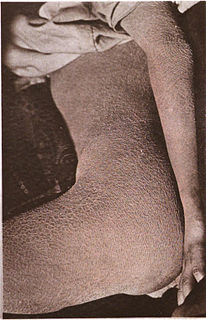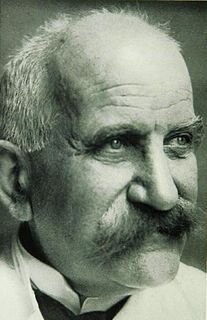Related Research Articles

Victor Babeș was a Romanian physician, bacteriologist, academician and professor. One of the founders of modern microbiology, Victor Babeș is author of one of the first treatises of bacteriology in the world – Bacteria and their role in pathological anatomy and histology of infectious diseases, written in collaboration with French scientist Victor André Cornil in 1885. In 1888, Babeș underlies the principle of passive immunity, and a few years later enunciates the principle of antibiosis. He made early and significant contributions to the study of rabies, leprosy, diphtheria, tuberculosis and other infectious diseases. He also discovered more than 50 unknown germs and foresaw new methods of staining bacteria and fungi. Victor Babeș introduced rabies vaccination and founded serotherapy in Romania.

Ichthyosis is a family of genetic skin disorders characterized by dry, thickened, scaly skin. The more than 20 types of ichthyosis range in severity of symptoms, outward appearance, underlying genetic cause and mode of inheritance. Ichthyosis comes from the Greek ἰχθύς ichthys, literally "fish", since dry, scaly skin is the defining feature of all forms of ichthyosis.

Joseph (Josef) Jadassohn was a German dermatologist.

Sjögren–Larsson syndrome is a rare autosomal recessive form of ichthyosis with neurological symptoms. It can be identified by a triad of medical disorders. The first is ichthyosis, which is a buildup of skin to form a scale-like covering that causes dry skin and other problems. The second identifier is paraplegia which is characterized by leg spasms. The final identifier is intellectual delay.
Alfred Blaschko was a German dermatologist who was a native of Freienwalde an der Oder.

Genodermatosis is a hereditary skin disease with three inherited modes including single gene inheritance, multiple gene inheritance and chromosome inheritance. There are many different types of genodermatosis, the prevalence of genodermatosis ranges from 1 per 6000 people to 1 per 500,000 people. Genodermatosis has influence on the texture, color and structure of skin cuticle and connective tissue, specific lesion site and clinical manifestations on the body vary depending on the type. In the spite of the variety and complexity of genodermatosis, there are still some common methods that can help people diagnose. After diagnosis, different types of genodermatosis require different levels of therapy including interventions, nursing interventions and treatments. Among that, research of therapy for some new, complex and rare types are still in the developing stage. The impact of genodermatosis not only can be seen in body but also can be seen in all aspects of patients’ life, including but not limited to psychological, family life, economic conditions and social activities. Accordingly, the patients need treatment, support and help in these areas.

Martin Bernhardt was a noted German neuropathologist.

Edmund Lesser was a German dermatologist who was a native of Neisse.

Ichthyosis bullosa of Siemens is a type of familial, autosomal dominant ichthyosis, a rare skin disorder. It is also known as bullous congenital ichthyosiform erythroderma of Siemens or ichthyosis exfoliativa. It is a genetic disorder with no known cure which is estimated to affect about 1 in 500,000 people.
Eclabium means the turning outwards of the lip. Eclabium comes from the Greek word "ek" meaning "out," and the Latin word "labium" meaning "lip." This deformation occurs in most babies born with Harlequin type ichthyosis, caused by genetic defects. Eclabium can severely impact the quality of life. There are ways to predict if a child will have this condition before they are born through genetic testing. For patients who suffer from eclabium due to improper wound healing, there are different treatment options available to restore the lips back to normal or at least to the point where they are not a hazard to the patients quality of life. Periodontitis can also cause eclabium. As eclabium is a symptom, it is treated by addressing its cause. When the underlying disease is treated, the eclabium tends to go away as well.
Hermann Werner Siemens was a German dermatologist who first described multiple skin diseases and was one of the inventors of the twin study. Siemens' work in twin studies is influential in modern genetics and is used to address the environmental and genetic impacts upon traits. Siemens was involved in racial hygiene and affiliated with the Nazi Party.

(William Henry) Irwin McLean FRS FRSE FMedSci is Emeritus Professor of Genetic Medicine, at the School of Life Sciences, University of Dundee.
Georg Wildführ was an East German Medical microbiologist and Hygienist.

Carl Posner was a German urologist.

Werner Spalteholz was a German anatomist.
Ernst Kromayer was a German dermatologist. He was the younger brother of historian Johannes Kromayer (1859–1934).
Johann Heinrich Rille was an Austrian dermatologist and venereologist.

Leo von Zumbusch was an Austrian-German dermatologist. He was the son of sculptor Kaspar von Zumbusch (1830–1915).

Rudolf Paul Joachim Kochendörffer was a German mathematician who was a Professor of mathematics in the University of Rostock specialising in algebra, Group theory and theory of finite groups and their representation. During World War II, Kochendörffer worked as a mathematical cryptanalyst in the mathematical referat of Inspectorate 7/IV, that would later become part of Referat I of Group IV of the General der Nachrichtenaufklärung, the signals intelligence agency of the Wehrmacht and was known as a cryptographic tester of the Enigma cipher machine. Kochendörffer was a Member of the Scientific Advisory Council for Mathematics at the State Secretariat for the Higher and Specialist Schools of the GDR, a staff member of Mathematical Reviews and collaborated with the Zentralblatt MATH

Hans Haustein was a Jewish doctor and scientist in the Weimar Republic.
References
- ↑ Prof. Dr. med. Rudolf Erhard Riecke Catalogus Professorum Lipsiensium
- 1 2 Rudolf Erhard Riecke at Who Named It
- ↑ Dermatology by Otto Braun-Falco, Gerd Plewig, Helmut H. Wolff, Richard K. Winkelmann.
- ↑ Ichthyosis Congenita AMA Am J Dis Child. 1957;93(3):259-262. doi:10.1001/archpedi.1957.02060040261011
- ↑ HathiTrust Digital Library published works
- ↑ Rudolf Erhard Riecke - bibliography at Who Named It